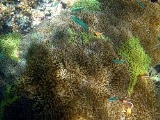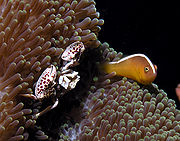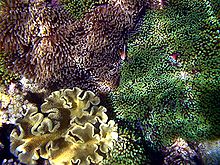
Amphiprion akallopisos
Encyclopedia
The skunk clownfish or nosestripe anemonefish, Amphiprion akallopisos, is an anemonefish (also called clownfish) that lives in association with sea anemone
s. A. akallopisos, like A. percula, is nearly always associated with Heteractis magnifica
and Stichodactyla gigantea
http://www.marinespecies.org/aphia.php?p=taxdetails&id=212770, and is found in the Indo-Pacific
. It resides in shallow inshore reefs as deep as 15 m with a moderate to strong current. The skunk clownfish can also be kept in captivity by aquarists.
 The skunk clownfish is identified by a light orange color, with a single, narrow, white stripe running from the mouth to the caudal peduncle, and can grow as large as 11 cm in length.http://www.fishbase.org/Summary/speciesSummary.php?ID=8017&genusname=Amphiprion&speciesname=akallopisos
The skunk clownfish is identified by a light orange color, with a single, narrow, white stripe running from the mouth to the caudal peduncle, and can grow as large as 11 cm in length.http://www.fishbase.org/Summary/speciesSummary.php?ID=8017&genusname=Amphiprion&speciesname=akallopisos
Like other anemonefish, the skunk clownfish is a protandrous hemaphrodite
, and maintains a hierarchy within the host anemone that consists of a mating pair, of which the female is the largest, and non-mating males which get progressively smaller in size.

es that produce a wide variety of sounds, a behavior shared with at least 10 species of anemonefish. Sounds resembling pops and chirps are most commonly heard when interacting with invading fish of the same species or different species. Studies have shown that it is the female that defends the anemone using sound production, as well as a physical charge when other fishes attempt to enter. A. akallopisos exhibit three different types of sounds, pops, short chirps, and long chirps, used depending on the type and duration of the encounter, which can also vary by locality.
Sea anemone
Sea anemones are a group of water-dwelling, predatory animals of the order Actiniaria; they are named after the anemone, a terrestrial flower. Sea anemones are classified in the phylum Cnidaria, class Anthozoa, subclass Zoantharia. Anthozoa often have large polyps that allow for digestion of larger...
s. A. akallopisos, like A. percula, is nearly always associated with Heteractis magnifica
Heteractis magnifica
Heteractis magnifica, also known by the common names magnificent sea anemone or Ritteri anemone, is a species of sea anemone that lives in the Indo-Pacific area, and can grow up to 1 metre in diameter in the wild. It can be kept in aquaria but is considered one of the most challenging species...
and Stichodactyla gigantea
Stichodactyla gigantea
Stichodactyla gigantea, commonly known as the giant carpet anemone is a species of sea anemone that lives in the Indo-Pacific area, with a diameter usually no larger than 50 centimetres and a maximum of 80 centimetres. It can be kept in an aquarium but is a very challenging species to keep alive...
http://www.marinespecies.org/aphia.php?p=taxdetails&id=212770, and is found in the Indo-Pacific
Indo-Pacific
The Indo-Pacific is a biogeographic region of the Earth's seas, comprising the tropical waters of the Indian Ocean, the western and central Pacific Ocean, and the seas connecting the two in the general area of Indonesia...
. It resides in shallow inshore reefs as deep as 15 m with a moderate to strong current. The skunk clownfish can also be kept in captivity by aquarists.
Description

Like other anemonefish, the skunk clownfish is a protandrous hemaphrodite
Hermaphrodite
In biology, a hermaphrodite is an organism that has reproductive organs normally associated with both male and female sexes.Many taxonomic groups of animals do not have separate sexes. In these groups, hermaphroditism is a normal condition, enabling a form of sexual reproduction in which both...
, and maintains a hierarchy within the host anemone that consists of a mating pair, of which the female is the largest, and non-mating males which get progressively smaller in size.

Territorial behaviors
The skunk clownfish, and other clownfish, use sound production to defend their territory. This behavior is most common with damselfishDamselfish
Damselfish comprise the family Pomacentridae except those of the genera Amphiprion and Premnas. They can grow up to long. While most are marine, a few species inhabit the lower stretches of rivers in freshwater. Damselfish usually have bright colors. in tropical coral reefs, and many of those are...
es that produce a wide variety of sounds, a behavior shared with at least 10 species of anemonefish. Sounds resembling pops and chirps are most commonly heard when interacting with invading fish of the same species or different species. Studies have shown that it is the female that defends the anemone using sound production, as well as a physical charge when other fishes attempt to enter. A. akallopisos exhibit three different types of sounds, pops, short chirps, and long chirps, used depending on the type and duration of the encounter, which can also vary by locality.
External links
- MarineSpecies.org
- Care information for Amphiprion akallopisos

